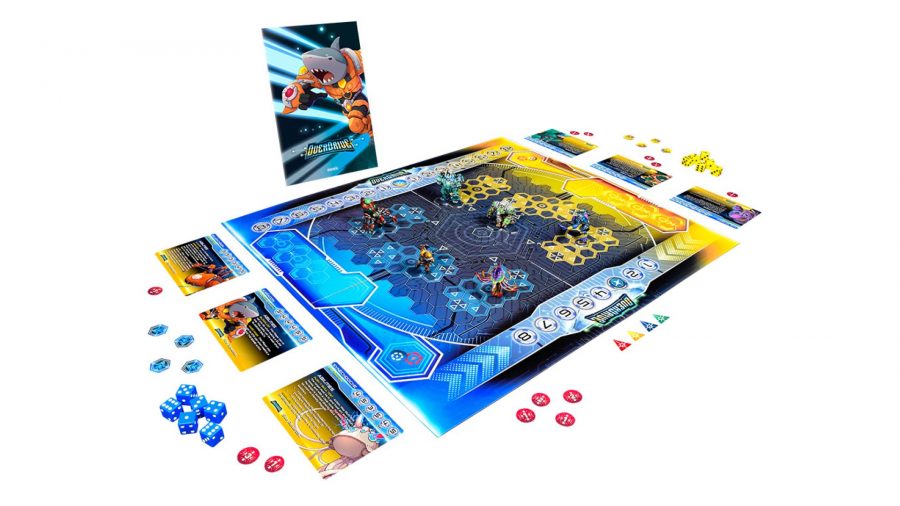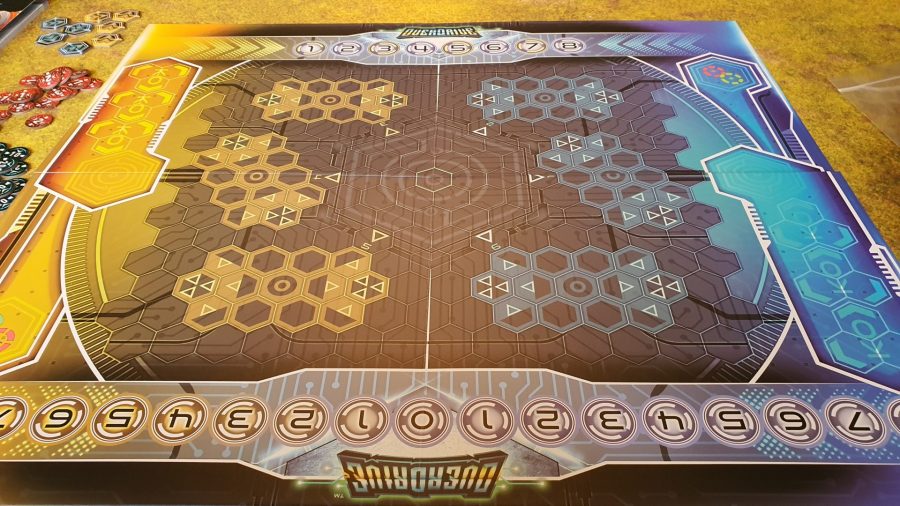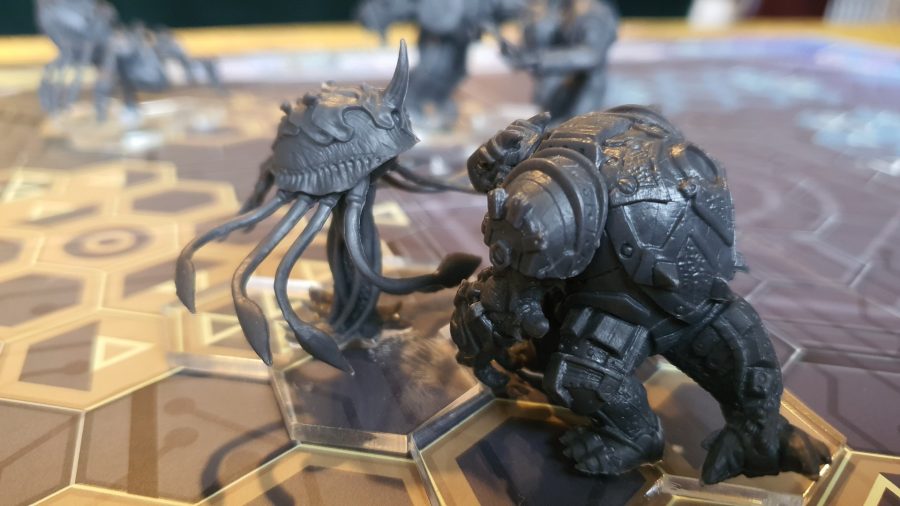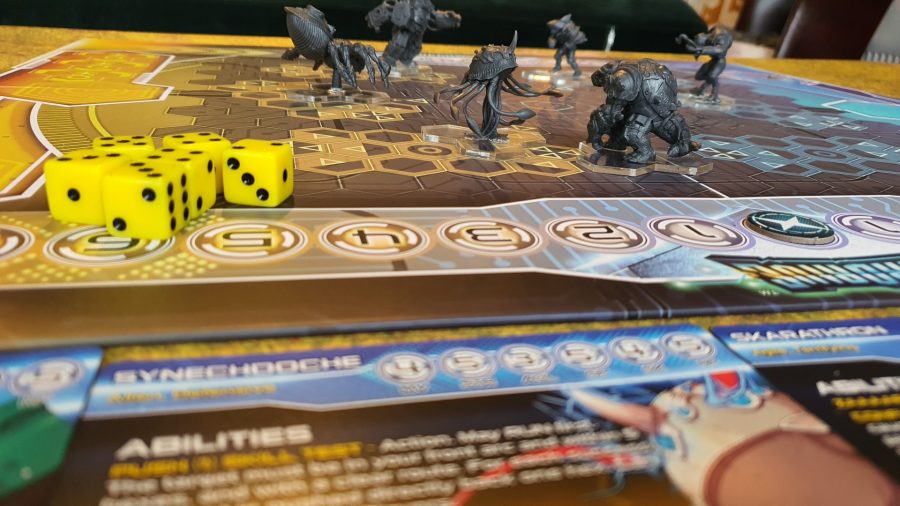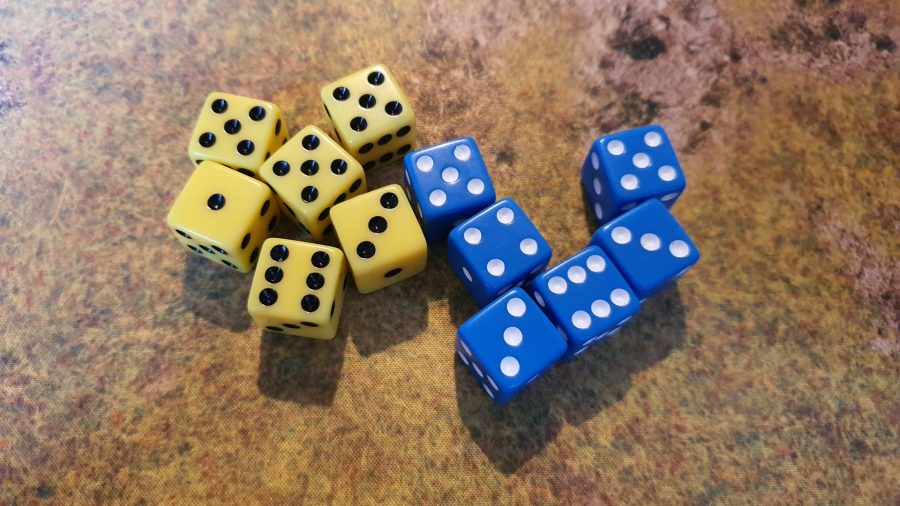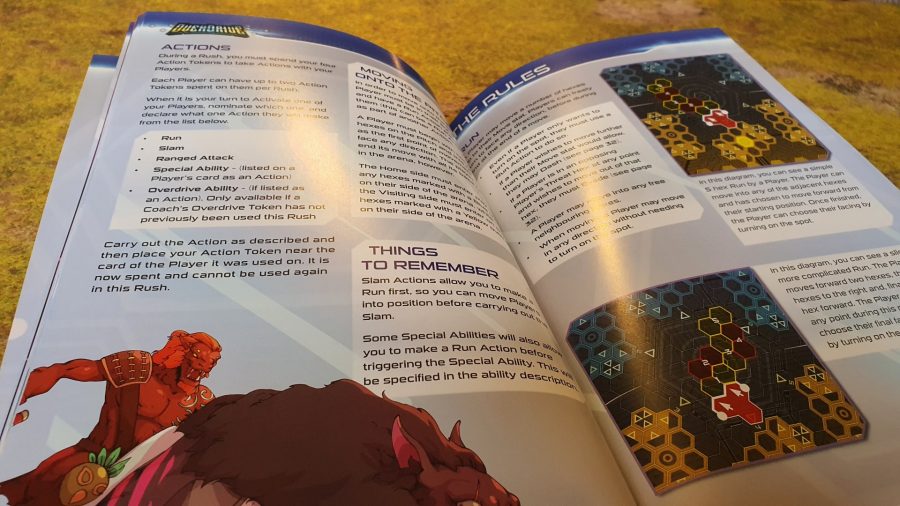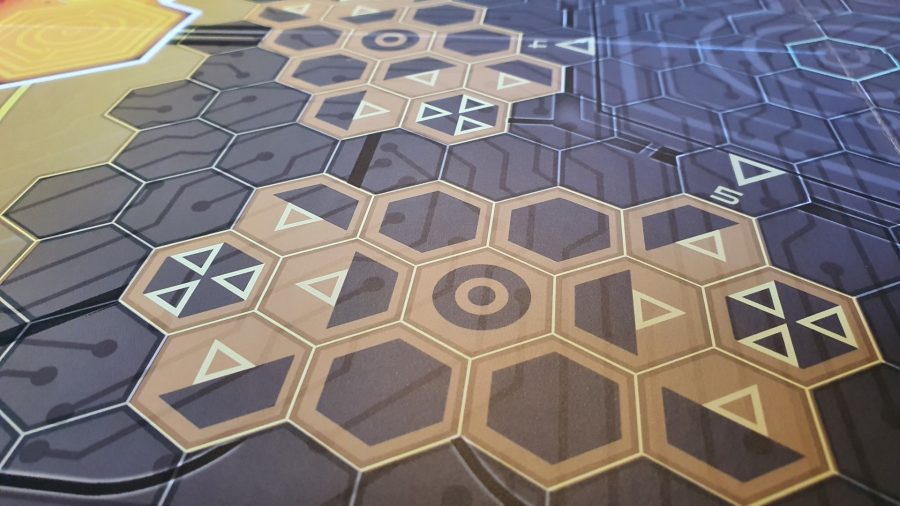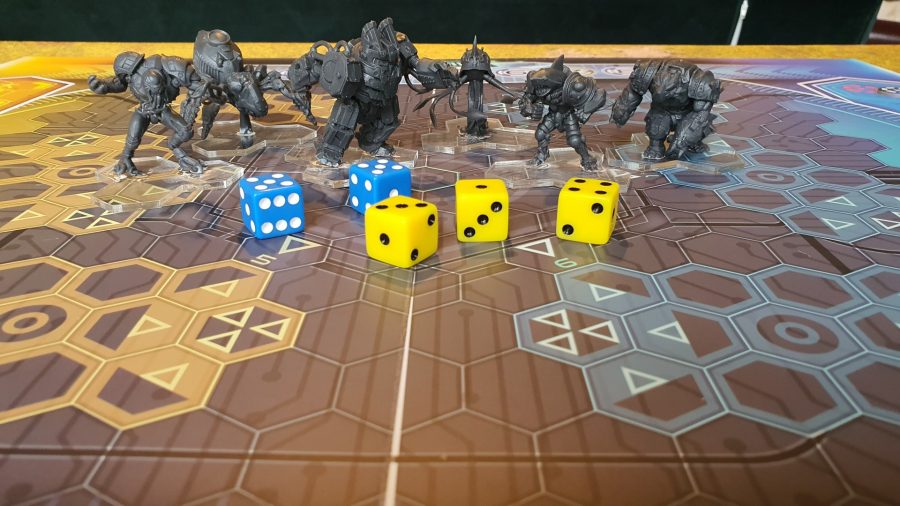Mantic Games’ OverDrive may be a light-hearted arena battler, but it has more depth than you might expect from a game whose box art features a cartoon of a shark-headed man shoulder barging a plate-armoured dinosaur. After a few games, I’m one part impressed, one part aggravated, and three parts curious to play a lot more. Let’s get a bit of background.
Based in Nottingham, UK (just a tram-ride from the Emperor of the miniatures industry, Games Workshop), Mantic is best known for Kings of War, a big-table, ‘rank and flank’ fantasy miniature wargame that’s a lot like Warhammer Fantasy Battle (except that it still exists). In 2013, Mantic released Dreadball – its own, sci-fi answer to GW’s sporty side-piece Blood Bowl – in which teams of gritty futuristic fighters compete to carry a ball to target areas of the board (while maiming each other). And, in 2021, the firm has given Dreadball its very own spin-off: OverDrive.
Canonically, it’s a spectator sport that grew out of a Dreadball half-time show, in which overgrown, superhuman Dreadball players beat the crap out of each other. Mechanically, it’s a slimmed down, three-a-side version of Dreadball, with the cheery aesthetics of TimeSplitters 2, and characterful, named heroes that walk, talk, and quack like champions in a MOBA PC game like League of Legends or DOTA 2. Interest piqued?
Good, because Mantic has kindly sent Wargamer a free copy of the core box to review – so, after playing through a couple of games, and poring carefully over the game’s various, eye-wateringly colourful components, I can share my impressions. We’ll start at the beginning:
OverDrive – what do you get?
This $75 / £50 ‘core’ box is OverDrive’s big entrance onto the scene, including everything you need to play any of the game’s six modes, either as a one-off match, or in the ‘league’ mode.
Here’s your lot:
- Six pre-assembled ‘player’ miniatures, in PVC hard plastic
- Six transparent plastic tri-hex bases to superglue them to
- Six player cards, listing each giant’s stats and abilities
- A gorgeously printed, 56-page softback rulebook
- A lovingly oversaturated, heavy duty folding game board
- 12 d6 dice (six yellow, six blue)
- 63 tokens
The materials are of pleasingly above-average quality. Expense has, perhaps, been spared on beautifying the highly out-of-place, ugly brown cardboard inner box, in order to spend the cash where it matters more: an excellent, hard-wearing game board; nice thick tokens; full size dice; outstanding minis. I can dig it.
The rulebook is a delight – but needs some basic hobby guidance
The rulebook, as with all Mantic box sets we’ve seen so far, is a pleasure, with lovely print quality, nice vivid artworks, and a very generous serving of lore content interspersed with the game rules. That said, for all its oodles of one-pager short stories (which undoubtedly add colour, humour, and personality to the proceedings), one omission stands out: there’s absolutely no ‘hobby guidance’ to new players about basing, and/or painting their miniatures, ready to play.
This is all the more significant because, as you can see, OverDrive uses snazzy, see-through tri-hex bases, whose front and rear ‘arcs’ are crucial to gameplay. Stick your lads on the wrong way round, and you’re liable to have a bad day. For the avoidance of doubt: the line of two hexes forms the base’s front; the one hex is its rear.
Now, if you read the rulebook properly before reaching for the glue, you’ll soon work out how to glue your little monsters down in the right orientation; and – since this is far closer to a board game than a pure-bred miniatures game – I could understand an instinct to cut back on the army-building bumf in the rulebook, and get straight into how to play.
But, in a gloriously noob-friendly production like this (where Mantic has already gone to the trouble of making pre-assembled PVC minis, instead of its usual resin or soft plastic sprues) it felt odd to lack a “get started” section, right at the beginning, that says things like: “glue them down like this“, and “use this type of glue” – or, at the very least, a simple diagram – before diving into the rules and lore.
Superior: These are the best board games available
I’ve built a lot of models for many different games, and even I felt momentarily confused setting up these beautiful minis correctly – which bodes poorly for first-timers. It may sound like a petty quibble – but, in a game where models’ facing is so vital for gameplay and immersion, ensuring the written materials explain exactly how to get those minis ready to play would cost little, and pay off big time in accessibility.
Just as there’s no downside to including an Easy Mode in a videogame (because those who don’t want it, don’t have to play it), tabletop game makers shouldn’t shy away from providing step by step modelling instructions, simply because their core crowd don’t need such fripperies. OK, I’ve had my soap box moment – let’s talk about those minis.
OverDrive – the miniatures
The core box comes with six ‘players’, a.k.a. ‘giants’, all of whom are reassuringly solid, and, once safely affixed to their bases, have a satisfying heft and physicality on the board – even the spindlier chaps.
These are the ones included:
- Karadon – the hunky shark man on the cover
- Brank Reborn – A big, tanky robot (think Blitzcrank from League of Legends)
- Skarathron – A fast-moving mechanical spider with a poison zap gun
- Synechdoche – A floaty psychic jellyfish who can control minds
- Dozer – A hulking, heavily armoured dinosaur tortoise lady
- The Spawn – a humanoid mass of tentacles with a face like Cthulhu
On the one hand, I found these models to be quite badly afflicted with the downsides of their chosen material: yes, there are prominent mould lines, and no, because it’s hard PVC, there isn’t an easy way to shave them off most areas without making a mess. There will be lines, and I’ve had to make my peace with them – but it’s still a bit disappointing.
Take control: These are the very best strategy board games
On the other, OverDrive’s six included miniatures are a joyful, diverse, and engaging set of sculpts that draw you right into the game’s neon cyborg kaleidoscope of a theme (even if you came into this feeling distinctly sniffy about it, like I did). No pose is duplicated, no character is quite alike, and every single one positively demands painting with the stupidest colour scheme you can fathom. These minis simply exude fun, and that’s more than you can say for most (non-goblin) Warhammer sculpts since about 2010. I really, really like them.
OverDrive – the gameplay
Once you get into the swing of its gameplay, OverDrive is straightforward, but relentlessly pacy, and feels increasingly competitive as you learn the ropes. Your first game might take you a couple of hours as you learn the rules, but once you’ve got it down, matches can be blasted through in under 60 minutes.
Players alternate activations – trying to clobber enemies and achieve objectives on the field
Like Dreadball, a match is played over eight ‘Rushes’ (rounds). In each Rush, each player gets four actions, with players taking turns to do a single action with one of their giants, aiming to knock out opponents via dice-driven combat, and/or complete objectives (as prescribed by the game mode). The basic two actions, Run and Slam, are available to all, and are more or less exactly what they sound like: your ‘move’ and ‘fight’ actions.
But individual giants also get their own personal special abilities (The Spawn reels in enemies with their tentacles, while Dozer can teleport out of a fight and hide in her armoured shell). And, once per Rush, one of your dudes can trigger their ultimate, or ‘Overdrive’ ability (Brank Reborn, for example, triggers a simultaneous Slam attack against every enemy giant within three hexes).
Almost all these actions are resolved through dice-roll ‘tests’ against one of the active giant’s stats (listed on its card as Strength 4+; Agility 3+; and so on, where a roll of that number or higher is a pass). You roll three ordinary d6 dice (sometimes more, or less, due to situational modifiers), and count your successes based on the relevant stat, to see if you successfully Did The Thing.
Adding colour: Read our beginner’s guide to painting miniatures
If you’re Slamming, the target gets to roll one of their skills to either Dodge you, or Slam you back, and the best roll wins. Damage gets lumped out equal to the difference in the rolls. Oh, and every test has infinitely exploding sixes – that is, every roll of a six is a success and triggers an extra roll, which, on a six, explodes again, and so on.
Some abilities interact in peculiar ways, and others are specific to certain game modes, but, really, the above describes 90% of OverDrive. After the first few Rushes, you’ll be rolling all the tests at light speed, with dice flying everywhere, sixes exploding all over the shop, and lots of noisy stuff going on.
At first, I rolled a lot of dice – and not much happened
Ay me, but there’s the rub: after my first match of OverDrive (against myself), I already had the feeling I’d experienced the top and bottom of its gameplay. I’d used every giant’s personal abilities a few times; triggered most of their ‘ultimate’ abilities, and executed numerous Runs, Slams, and Dashes between different targets and scoring zones. I’d rolled a buttload of dice. And not an awful lot had happened. A grand total of one giant had been KOd; zones had been captured on either side, though in far from every Rush; fun had been had – but the final score was a dismal 0:0 draw.
And it really did feel like the game’s fault. Since every giant has a decent score in either Strength or Agility, head-on Slams are basically a straight-up dice game, where just one or two lucky rolls will see the would-be Slam-ee escaping unharmed over and over again, however burly the attacker, and however squishy the target.
Even the supposedly super-powered Overdrive moves can have their wings clipped by the dice gods; once, I successfully used Synechdoche’s (awesome) Mind Control Overdrive ability, took over the other team’s Dozer, and Slammed her right into her own teammate – who promptly had a lucky Dodge roll, ensuring that nothing whatsoever happened and the whole action was a wash. It was not fun. I had to be missing something.

And indeed I was: OverDrive’s simple, but effective, positioning play. Those tri-hex bases grant the game more immersion and physicality than you’d think, purely by giving your models a ‘front’ and a ‘back’. Unlike most arena battlers (which plonk each little dude on a single hex, and pay little mind to sides or directions) in this game, your giants apply debuffing ‘threat’ effects to hexes directly in front of them, and are extra vulnerable to attacks from behind (losing the ability to Slam back, and rolling only two dice to Dodge instead of three). This is a very big deal.
Double act: These are the best 2 player board games out there
Once you start factoring those ‘threat hexes’, base positions, and enemies’… ahem… ‘rear arcs’ into your tactical decisions, that’s when OverDrive really kicks into gear. Do you risk a Dash to get to that scoring zone, knowing that anything other than a perfect roll will leave your hindquarters within range of a running Slam from a nearby Brank or Dozer? Do you use Skarathron’s high move stat to zip out and harrass distant enemies; or simply position them just so, so as to block a speedy opponent’s only route to the objective? This single extra layer of complexity expanded my tactical options so much as to transform my view of the game – and my desire to play more.
It’s worth noting, too, that I’ve only had a chance to play the standard King of the Hill game mode (which has every giant racing to occupy a randomly selected scoring area) – and the game’s rulebook packs four other full-blown modes:
- Capture the Flag
- Pass the Bomb
- Invade
- Killstreak
- Dodgebrawl
OverDrive’s gameplay remains, by design, a fast flowing, accessible, and ultimately simplistic system – but, with so many modes included at launch to shake things up, Mantic has provided for a good amount of variety in games. I look forward to diving into more of them.
The proof will come in time, of course. Creating more variety and complexity requires a wider range of different rule interactions and matchups; which, in turn, requires a larger roster of distinct giants to play with; and that requires that Mantic makes enough money from the core game to make it a ‘goer’, financially. I will watch with interest.
OverDrive – who’s it for
At $75 / £50, this box is priced exactly in line with Games Workshop’s Warhammer Underworlds core set – which is, indeed, its closest opposite number in the GW line-up. Both are hex-board games with a handful of models per team, each with their own stats; both have you compete to control objective hexes, without getting clobbered on the way; and both, to an extent, are designed to attract new players into their respective gaming universes.
In reality, though, OverDrive isn’t gunning for the same experience as Underworlds at all. There’s no slow and steady pre-game deck building, combo-crafting, or card play here. The tactical nuance comes, instead, from learning each giant’s specialities and pitfalls; mastering the game’s facing rules to control key areas and flank enemies; and squeezing the maximum competitive value out of both, while also riding the wave of an extremely fast-moving game where RNG is, if not king, then at least an incredibly influential baron. If that sounds frantic and frustrating to you, well, you might not enjoy OverDrive much.
Good times: We rate these as the absolute most fun board games
From my short time with the game so far, OverDrive feels like a perfect gateway skirmish game for people who enjoy the team-drafting, competitive, sporty energy of PC MOBAs. Games are quick, and the rules are simple – but there’s enough hidden depth in its positioning game to teach new players all kinds of transferable skills for games like X-Wing, and full-on wargames beyond.
Plus, like Godtear, OverDrive offers a roster of conceptually distinct, individual hero minis with particular in-game abilities, strengths, and weaknesses, then lets you mix and match your favourites – rather than making you choose from wargame-style, non-mixable, expandable ‘factions’. It’s a formula that dissolves many of such games’ traditional barriers to entry, and, while having a shared pool of individual, factionless giants could get a bit complicated down the line – when you and your pals are deciding who buys what – in this initial launch phase, it seems like a strength.
OverDrive – verdict
In the final calculation, OverDrive is a simple, but surprisingly playable two-player arena skirmish game, with solid components, wonderful minis, and an endearing (if slightly overdone) cartoonish neon sci-fi aesthetic.
Get to grips with OverDrive, and you’ll find depth where you least expect
Initially, I found its dice-driven, tug-of-war gameplay frustrating, with universally strong defensive stats, and a lack of true ‘rock paper scissors’ matchups, leading to a hell of a lot of dice being rolled, lots of sound and fury, but almost no damage actually getting dealt. Get to grips with OverDrive’s clever system of strategic moves, positioning , model facings, and flanking attacks, however – and you’ll find an extra serving of depth and tactical variety where you least expect it.
I was a doubter, but now I’m a convert. I’ve sent off for my translucent plastic trench coat, bionic eye, cyborg parrot, and Day-Glo yellow mechanical trousers, and I’m considering taking up smoking weird purple cigars. Mum, I’m going away to space to coach a team of massive alien gladiators for a living. Don’t wait up.
Source: Wargamer



